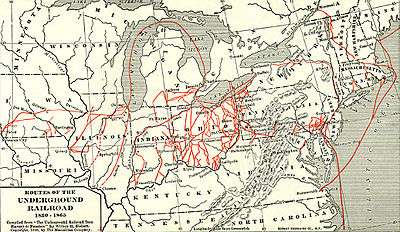Jerry Rescue
The Jerry Rescue occurred on October 1, 1851, and involved the public rescue of a fugitive slave who had been arrested the same day in Syracuse, New York, during the anti-slavery Liberty Party's state convention. The escaped slave was William Henry, a 40-year-old cooper from Missouri who called himself "Jerry."[1]
The plan to rescue him was hatched in the South Warren Street office of Dr. Hiram Hoyt of Syracuse.
Background
New York was sympathetic towards to slaves because it was a free state, and a number of abolitionists lived in the area. Syracuse became an active center for the abolitionist movement due in large part to the influence of Gerrit Smith, from Madison County, and a group allied with him, mostly associated with the Unitarian Church and their pastor, Reverend Samuel May, in Syracuse, as well as Quakers in nearby Skaneateles, supported by abolitionists in many other religious congregations.[2] Other prominent abolitionists from the area were Frederick Douglass, Millard Fillmore, Matilda Joslyn Gage, John W. Jones, William Marks and Harriet Tubman.[3] Prior to the Civil War, due to the work of Reverend Jermain Wesley Loguen (a fugitive slave himself) and others in defiance of federal law, Syracuse became known as the "great central depot on the Underground Railroad." Its central location meant that many slaves passed through while traveling to freedom in Canada.[3]
Arrest and rescue
On October 1, 1851, William "Jerry" Henry was arrested in Syracuse as a fugitive slave. Earlier in 1851, Secretary of State Daniel Webster had warned that the new Fugitive Slave Law would be enforced even "here in Syracuse in the midst of the next Anti-Slavery Convention."[1] The arrest was considered a message that the locally-unpopular law would be enforced by federal authorities.[1]
The abolitionist Liberty Party was holding a state convention in Syracuse, and when the arrest became known, several hundred abolitionists, including Charles Augustus Wheaton, broke into the city jail and freed the fugitive. The event came to be widely known as the Jerry Rescue. "Jerry" was hidden in Syracuse for several days, then was taken to the Orson Ames House in Mexico, New York, and from there to Oswego, before crossing Lake Ontario into freedom in Canada.[2][4]
African-American minister Samuel Ringgold Ward, who participated in the rescue, had to flee to Canada to escape prosecution under the Fugitive Slave Act.[2]
Trial
The trial took place that same day in the Townsend Building in Clinton Square, Syracuse, in the second floor office of the U.S. Commissioner Sabine, who tried the case. It was his first trial. Jerry had escaped during the afternoon session, and Sabine's office was wrecked.[5]
A total of 26 of the rescuers were tried for their actions, but only one, Enoch Reed, a black man, was convicted.[4] The suspects' bonds were paid by a number of people, including U.S. Senator William H. Seward.[2] Nine others, including Loguen, were charged, but fled to Canada.[4]
Jerry Rescue building

The event was commemorated in the 1850s when the Townsend Block was renamed the Jerry Rescue Building, which is no longer standing.[6] The building, constructed in 1829,[7] was located on the south side of Clinton Square, at the corner of Water and Clinton Streets.[5] The event is now commemorated with a monument in Clinton Square, Syracuse.[2]
Underground Railroad homes in the state of New York

- William H. Seward House - 33 South Street, Auburn
- Harriet Tubman Home - 180 South Street, Auburn
- John W. Jones House - 1250 Davis Street, Elmira
- Harriet May Mills House - 1074 West Genesee Street, Syracuse
- James Canning Fuller and Lydia Charleton Fuller House - 98 West Genesee Street, Skaneateles
- Matilda Joslyn Gage House - 210 East Genesee Street, Fayetteville
- Hunt House - 401 East Main Street, Waterloo
- M'Clintock House - 14 East William Street, Waterloo
- Rose Hill Mansion - State Route 96A, Hamlet of Rose Hill, Fayette
- Esperanza Mansion - 3456 State Route 54A, Keuka Park
See also
- Joshua Glover, another slave who was rescued in similar circumstances in 1854
References
- Bordewich, Fergus M. (2005). Bound for Canaan: The Underground Railroad and the War for the Soul of America. Amistad. p. 333. ISBN 978-0-06-052430-2.
- "The Jerry Rescue". New York History Net. 2009. Retrieved August 15, 2009.
- "The Underground Railroad in the Finger Lakes". Ronda Roaring. 2006. Retrieved December 3, 2010.
- Bordewich, Fergus M. (2005). Bound for Canaan: The Underground Railroad and the War for the Soul of America. Amistad. p. 339. ISBN 978-0-06-052430-2.
- "Where First Hearing in Jerry Case Took Place". NYPL Digital Gallery. 2010. Retrieved December 3, 2010.
- "The 'Jerry Rescue' Building". Syracuse Then and Now. Retrieved August 15, 2009.
- McGuinness, Walter F. (February 23, 1958). "A Year in Onondaga History". Syracuse Herald Journal. Syracuse, New York.
